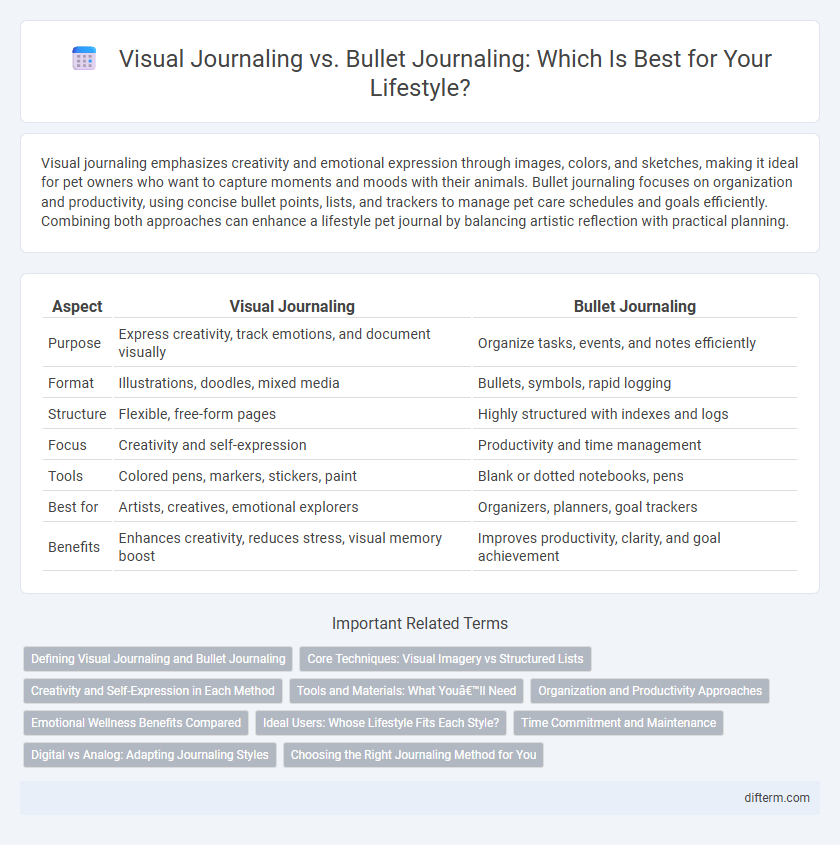Visual journaling emphasizes creativity and emotional expression through images, colors, and sketches, making it ideal for pet owners who want to capture moments and moods with their animals. Bullet journaling focuses on organization and productivity, using concise bullet points, lists, and trackers to manage pet care schedules and goals efficiently. Combining both approaches can enhance a lifestyle pet journal by balancing artistic reflection with practical planning.
Table of Comparison
| Aspect | Visual Journaling | Bullet Journaling |
|---|---|---|
| Purpose | Express creativity, track emotions, and document visually | Organize tasks, events, and notes efficiently |
| Format | Illustrations, doodles, mixed media | Bullets, symbols, rapid logging |
| Structure | Flexible, free-form pages | Highly structured with indexes and logs |
| Focus | Creativity and self-expression | Productivity and time management |
| Tools | Colored pens, markers, stickers, paint | Blank or dotted notebooks, pens |
| Best for | Artists, creatives, emotional explorers | Organizers, planners, goal trackers |
| Benefits | Enhances creativity, reduces stress, visual memory boost | Improves productivity, clarity, and goal achievement |
Defining Visual Journaling and Bullet Journaling
Visual journaling emphasizes creativity through sketches, collages, and mixed media to capture thoughts and emotions, enhancing mindfulness and self-expression. Bullet journaling uses a structured system of symbols, lists, and rapid logging to organize tasks, events, and goals efficiently, promoting productivity and time management. Both methods support personal development but cater to different cognitive and artistic preferences.
Core Techniques: Visual Imagery vs Structured Lists
Visual journaling emphasizes core techniques centered on visual imagery, using drawings, sketches, and symbols to capture thoughts and emotions, enhancing creativity and self-expression. Bullet journaling relies on structured lists, employing rapid logging with bullets, tasks, events, and notes to organize daily activities efficiently and boost productivity. Each method offers unique cognitive benefits, with visual journaling fostering intuitive thinking and bullet journaling promoting systematic planning.
Creativity and Self-Expression in Each Method
Visual journaling enhances creativity by allowing free-form drawing, collage, and mixed media, enabling personal expression through colors and images. Bullet journaling prioritizes structured organization with customizable symbols and rapid logging, supporting creativity within practical frameworks. Both methods foster self-expression but cater to different creative preferences--visual journaling encourages artistic exploration, while bullet journaling promotes creative efficiency and clarity.
Tools and Materials: What You’ll Need
Visual journaling requires a variety of art supplies such as sketchbooks, colored pencils, markers, paints, and adhesive materials to capture creativity through images and mixed media. Bullet journaling primarily relies on dotted or grid notebooks, fine-tip pens, rulers, and stencils to structure tasks, schedules, and notes efficiently. Both methods benefit from quality paper to ensure durability and vibrant expression, but visual journaling demands more diverse artistic tools compared to the minimalist setup of bullet journaling.
Organization and Productivity Approaches
Visual journaling enhances creativity and memory retention through the use of drawings, colors, and symbols, making it ideal for organizing ideas in a visually engaging manner. Bullet journaling employs a systematic framework with rapid logging, signifiers, and monthly logs, significantly boosting productivity by streamlining tasks, events, and goals. Both methods improve organization and productivity, but bullet journaling is particularly effective for structured task management, while visual journaling excels in fostering creative thinking and emotional expression.
Emotional Wellness Benefits Compared
Visual journaling enhances emotional wellness by allowing expressive art therapy, which helps process complex feelings through colors and imagery. Bullet journaling supports emotional health by organizing thoughts, tracking moods, and setting goals, fostering mindfulness and stress reduction. Both methods promote self-awareness, but visual journaling emphasizes creativity while bullet journaling prioritizes structure.
Ideal Users: Whose Lifestyle Fits Each Style?
Visual journaling suits creative individuals who thrive on expressing emotions and ideas through drawings, sketches, and colors, ideal for artists, designers, and those seeking an emotional outlet. Bullet journaling fits highly organized, productivity-focused users who prioritize task management, goal setting, and habit tracking, making it perfect for professionals, students, and planners. Both methods support personal growth but cater to distinctly different lifestyle needs and cognitive approaches.
Time Commitment and Maintenance
Visual journaling requires a moderate time commitment due to its focus on creative expression through drawings, colors, and mixed media, which can extend maintenance efforts. Bullet journaling emphasizes efficient organization with quick entry methods like symbols and bullet points, resulting in lower daily maintenance time but consistent updating. Both methods demand regular engagement, yet bullet journaling typically suits those seeking structured productivity with minimal time investment.
Digital vs Analog: Adapting Journaling Styles
Visual journaling emphasizes creative expression through sketches, colors, and images, thriving in both digital apps like Procreate or GoodNotes and traditional notebooks. Bullet journaling centers on organized, rapid logging of tasks and events, with digital adaptations using apps such as Notion and Todoist enhancing accessibility and customization. The choice between digital and analog depends on preferences for tactile engagement versus digital convenience and integration with existing productivity tools.
Choosing the Right Journaling Method for You
Visual journaling emphasizes creativity through drawings, sketches, and collage, making it ideal for those who express thoughts better with images. Bullet journaling offers structured organization via symbols, lists, and rapid logging, perfect for individuals seeking productivity and task management. Selecting the right journaling method depends on personal goals, whether prioritizing artistic expression or efficient planning.
Visual Journaling vs Bullet Journaling Infographic

 difterm.com
difterm.com